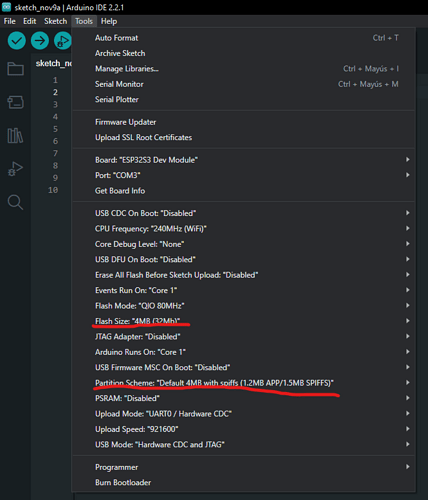Hi, I just recently started using Edge Impulse, and I just ran into an error where the console logs a Corrupt Heap Bad Tail error whenever I try to run my code. Here is the code I’m using below:
/* Edge Impulse ingestion SDK
* Copyright (c) 2022 EdgeImpulse Inc.
*
* Licensed under the Apache License, Version 2.0 (the "License");
* you may not use this file except in compliance with the License.
* You may obtain a copy of the License at
* http://www.apache.org/licenses/LICENSE-2.0
*
* Unless required by applicable law or agreed to in writing, software
* distributed under the License is distributed on an "AS IS" BASIS,
* WITHOUT WARRANTIES OR CONDITIONS OF ANY KIND, either express or implied.
* See the License for the specific language governing permissions and
* limitations under the License.
*
*/
/* Includes ---------------------------------------------------------------- */
#include <ianc-project-1_inferencing.h>
#include "I2Cdev.h"
#include "MPU6050.h"
#include "Wire.h"
/* Constant defines -------------------------------------------------------- */
MPU6050 imu;
int16_t ax, ay, az;
#define ACC_RANGE 1 // 0: -/+2G; 1: +/-4G
#define CONVERT_G_TO_MS2 (9.81/(16384/(1.+ACC_RANGE)))
#define MAX_ACCEPTED_RANGE (2*9.81)+(2*9.81)*ACC_RANGE
/* Private variables ------------------------------------------------------- */
static bool debug_nn = false; // Set this to true to see e.g. features generated from the raw signal
/**
* @brief Arduino setup function
*/
void setup()
{
// put your setup code here, to run once:
Serial.begin(115200);
// comment out the below line to cancel the wait for USB connection (needed for native USB)
while (!Serial);
Serial.println("Edge Impulse Inferencing Demo");
// initialize device
Serial.println("Initializing I2C devices...");
Wire.begin();
imu.initialize();
delay(10);
//Set MCU 6050 OffSet Calibration
imu.setXAccelOffset(-4732);
imu.setYAccelOffset(4703);
imu.setZAccelOffset(8867);
// imu.setXGyroOffset(61);
// imu.setYGyroOffset(-73);
// imu.setZGyroOffset(35);
imu.setFullScaleAccelRange(ACC_RANGE);
if (EI_CLASSIFIER_RAW_SAMPLES_PER_FRAME != 3) {
ei_printf("ERR: EI_CLASSIFIER_RAW_SAMPLES_PER_FRAME should be equal to 3 (the 3 sensor axes)\n");
return;
}
}
/**
* @brief Return the sign of the number
*
* @param number
* @return int 1 if positive (or 0) -1 if negative
*/
float ei_get_sign(float number) {
return (number >= 0.0) ? 1.0 : -1.0;
}
/**
* @brief Get data and run inferencing
*
* @param[in] debug Get debug info if true
*/
void loop()
{
ei_printf("\nStarting inferencing in 2 seconds...\n");
delay(2000);
ei_printf("Sampling...\n");
// Allocate a buffer here for the values we'll read from the IMU
float buffer[EI_CLASSIFIER_DSP_INPUT_FRAME_SIZE] = { 0 };
for (size_t ix = 0; ix < EI_CLASSIFIER_DSP_INPUT_FRAME_SIZE; ix += 3) {//3
// Determine the next tick (and then sleep later)
uint64_t next_tick = micros() + (EI_CLASSIFIER_INTERVAL_MS * 1000);
imu.getAcceleration(&ax, &ay, &az);
buffer[ix + 0] = ax;
buffer[ix + 1] = ay;
buffer[ix + 2] = az;
ei_printf("raw values: %.2f, %.2f, %.2f\n", ax*CONVERT_G_TO_MS2, ay*CONVERT_G_TO_MS2, az*CONVERT_G_TO_MS2);
buffer[ix + 0] *= CONVERT_G_TO_MS2;
buffer[ix + 1] *= CONVERT_G_TO_MS2;
buffer[ix + 2] *= CONVERT_G_TO_MS2;
for (int i = 0; i < 3; i++) {
if (fabs(buffer[ix + i]) > MAX_ACCEPTED_RANGE) {
buffer[ix + i] = ei_get_sign(buffer[ix + i]) * MAX_ACCEPTED_RANGE;
}
}
delayMicroseconds(next_tick - micros());
}
// Turn the raw buffer in a signal which we can the classify
signal_t signal;
int err = numpy::signal_from_buffer(buffer, EI_CLASSIFIER_DSP_INPUT_FRAME_SIZE, &signal);
if (err != 0) {
ei_printf("Failed to create signal from buffer (%d)\n", err);
return;
}
// Run the classifier
ei_impulse_result_t result = { 0 };
err = run_classifier(&signal, &result, debug_nn);
if (err != EI_IMPULSE_OK) {
ei_printf("ERR: Failed to run classifier (%d)\n", err);
return;
}
// print the predictions
ei_printf("Predictions ");
ei_printf("(DSP: %d ms., Classification: %d ms., Anomaly: %d ms.)",
result.timing.dsp, result.timing.classification, result.timing.anomaly);
ei_printf(": \n");
for (size_t ix = 0; ix < EI_CLASSIFIER_LABEL_COUNT; ix++) {
ei_printf(" %s: %.5f\n", result.classification[ix].label, result.classification[ix].value);
}
#if EI_CLASSIFIER_HAS_ANOMALY == 1
ei_printf(" anomaly score: %.3f\n", result.anomaly);
#endif
}
#if !defined(EI_CLASSIFIER_SENSOR) || EI_CLASSIFIER_SENSOR != EI_CLASSIFIER_SENSOR_ACCELEROMETER
#error "Invalid model for current sensor"
#endif
This code comes from this link. As for the whole error message displayed, it shows:
CORRUPT HEAP: Bad tail at 0x3fced090. Expected 0xbaad5678 got 0xdd952ced
assert failed: multi_heap_free multi_heap_poisoning.c:276 (head != NULL)
Backtrace: 0x40376662:0x3fceb2e0 0x4037aee9:0x3fceb300 0x403802f1:0x3fceb320 0x4037f48d:0x3fceb450 0x40377372:0x3fceb470 0x40380349:0x3fceb490 0x4201e8e1:0x3fceb4b0 0x4201d9e1:0x3fceb4d0 0x420079d1:0x3fceb4f0 0x42005d0a:0x3fceb510 0x42006165:0x3fceb570 0x42006d8e:0x3fceb620 0x42006fcb:0x3fceb6c0 0x4200438b:0x3fceb6f0 0x420044cd:0x3fceb780 0x4200472a:0x3fceb830 0x4200b289:0x3fcebe40
Any suggestions on how I can fix this?
